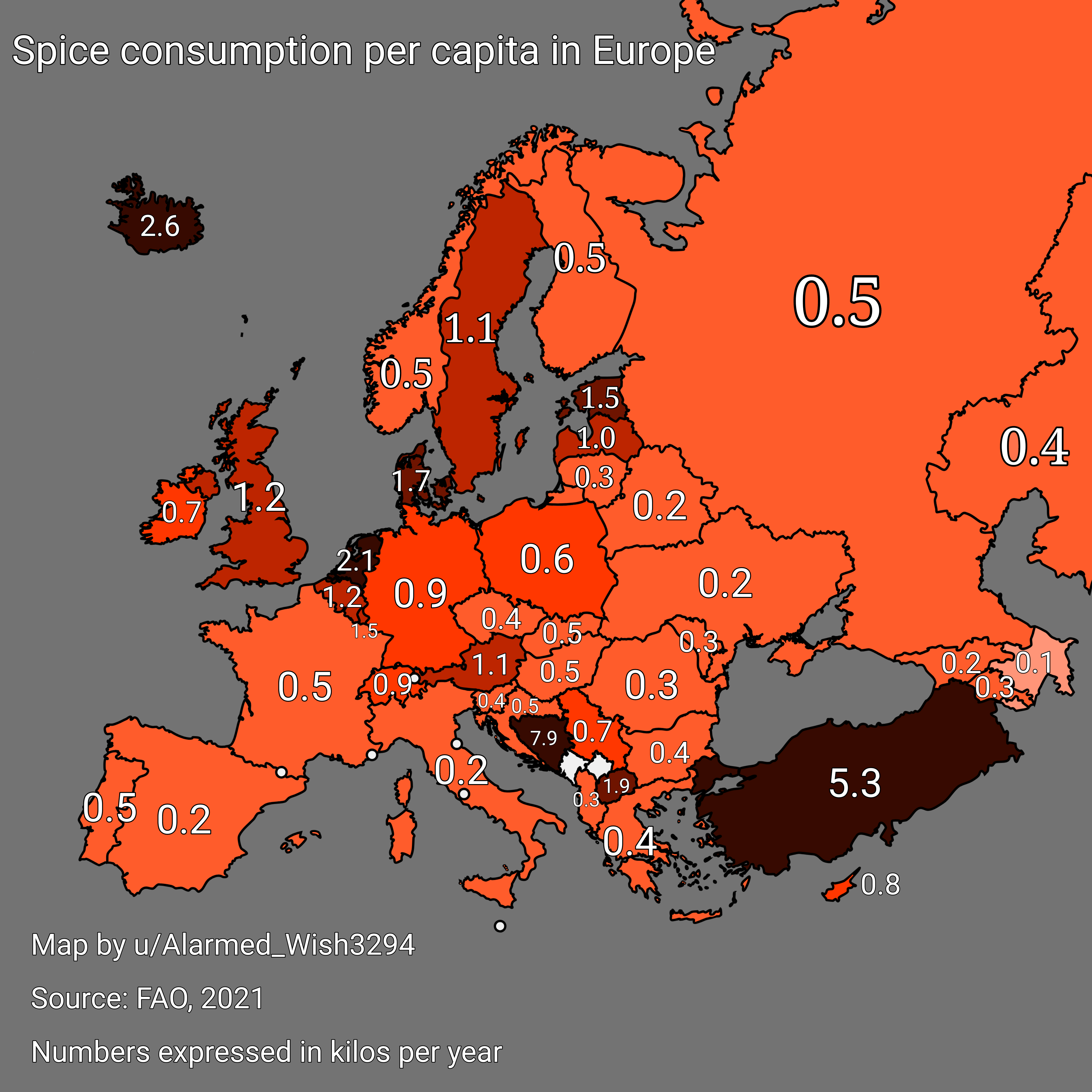Spice Consumption Per Capita in Europe Map


Marcus Rodriguez
Historical Geography Expert
Marcus Rodriguez specializes in historical cartography and geographic data analysis. With a background in both history and geography, he brings unique...
Geographic Analysis
What This Map Shows
The "Spice Consumption Per Capita in Europe, 2021" map provides a detailed visualization of how different European nations consume spices on a per capita basis. This intriguing map allows us to see not just the quantities of spices consumed, but also cultural preferences and culinary practices across the continent. Spices have played an essential role in European cuisine, influencing flavors and food traditions for centuries. With this map, we can observe the nuances in spice preferences, which can reveal much more than mere statistics—they reflect historical trade routes, colonial legacies, and even climate conditions that affect agriculture.
Deep Dive into Spice Consumption
Spice consumption is more than just a culinary preference; it’s a window into a country’s culture, economy, and history. Spices have been used for thousands of years, originating from various regions around the globe. Countries like India and Indonesia are well-known spice producers, and their exports have significantly shaped the culinary landscapes of Europe.
Interestingly, spice consumption varies widely across Europe. For instance, Mediterranean countries such as Spain and Italy often showcase higher spice consumption, particularly in the form of herbs like oregano, basil, and saffron. On the other hand, Northern European countries like Finland and Sweden tend to use fewer spices, focusing more on ingredients like potatoes and fish. The reasons behind these differences can be traced back to agricultural practices, climatic conditions, and cultural influences.
In terms of specific spices, it's notable that black pepper remains one of the most consumed spices worldwide, and Europe is no exception. Garlic, paprika, and chili are particularly popular in Southern and Eastern Europe, often used to enhance the flavors of traditional dishes. In fact, the use of chili has been skyrocketing in recent years, especially in countries like Hungary, where it complements the rich, hearty meals characteristic of the region.
Moreover, the rise of globalization and the internet has opened up new avenues for spice consumption, introducing exotic flavors to European kitchens. Ever wondered why you can find Indian curry powder in a Swedish supermarket? It's a testament to the interconnectedness of our modern world.
Regional Analysis
Breaking down the map by regions reveals fascinating patterns in spice consumption. In Southern Europe, we see high per capita consumption rates, with Spain leading the way. Spanish cuisine is famous for its use of saffron, particularly in paella, which is a staple dish in the region. Italy also shows significant spice use, especially in sauces and marinades. The use of herbs is particularly common here, reflecting both agricultural availability and culinary traditions.
Moving northwards, we see a dip in spice consumption. Scandinavian countries typically utilize fewer spices, with a focus on fresh ingredients and preservation methods like smoking or pickling. However, as global cuisine becomes more popular, younger generations in these countries are starting to experiment with spices, leading to slight increases in consumption.
Eastern European countries, such as Hungary, present an interesting case. Known for their use of paprika, these nations not only have a strong culinary identity tied to spice use but also have historical ties to spice trade routes, which have influenced their preferences. Interestingly, the map shows a notable spike in spice consumption in Bulgaria, likely due to the country's rich agricultural landscape and the use of spices in traditional dishes.
Significance and Impact
Understanding spice consumption in Europe is not just a matter of culinary interest; it has broader implications for trade, health, and environmental sustainability. The demand for spices influences agricultural practices, impacting how crops are grown and traded. Countries that heavily rely on spice exports may find themselves needing to adapt to changing climates and market demands.
Moreover, as public health campaigns promote the benefits of spices—such as antioxidants and anti-inflammatory properties—spice consumption might see an upward trend. This could lead to a healthier population, as spices are often used to flavor foods in place of salt and sugar, aligning with growing health trends across Europe.
As we move towards a more interconnected world, it's essential to recognize the role spices play in our diets and cultures. The future of spice consumption in Europe will likely be shaped by globalization, health trends, and a renewed interest in culinary exploration. As we’ve seen, the map not only depicts what spices are consumed but also hints at deeper narratives about culture, economy, and health that are interwoven into the fabric of European society.
Visualization Details
- Published
- September 13, 2025
- Views
- 76
Comments
Loading comments...